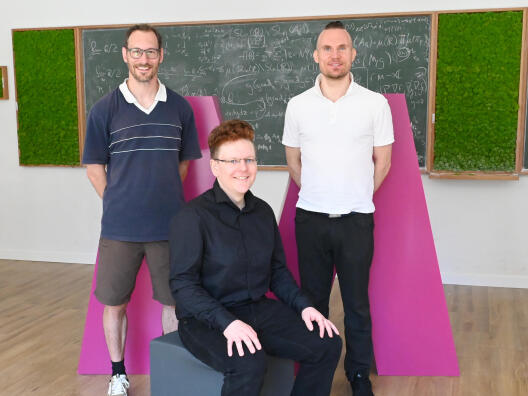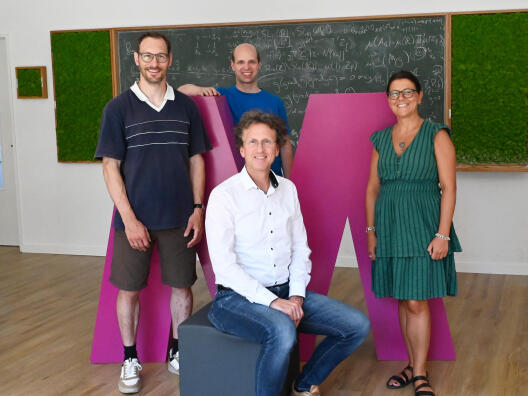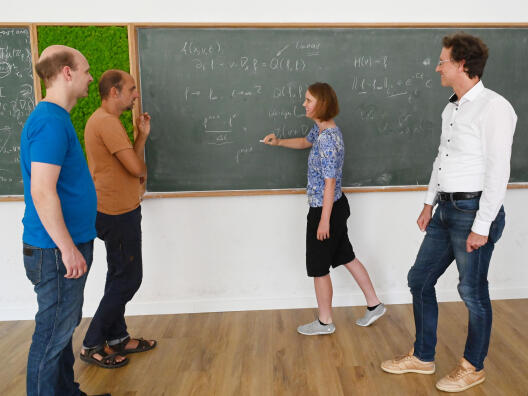since 2019
$\bullet $ Michael Kartmann, Tim Keil, Mario Ohlberger, Stefan Volkwein, and Barbara Kaltenbacher.
Adaptive reduced basis trust region methods for parameter identification problems.
Computational Science and Engineering, September 2024.
doi:10.1007/s44207-024-00002-z.
$\bullet $ M. Holler, A. Schlüter, and B. Wirth.
Dimension reduction, exact recovery, and error estimates for sparse reconstruction in phase space.
Applied and Computational Harmonic Analysis, 70:101631, May 2024.
doi:10.1016/j.acha.2024.101631.
$\bullet $ Tim Keil and Mario Ohlberger.
A relaxed localized trust-region reduced basis approach for optimization of multiscale problems.
ESAIM: Mathematical Modelling and Numerical Analysis, 58(1):79–105, January 2024.
doi:10.1051/m2an/2023089.
$\bullet $ Christian Engwer, Mario Ohlberger, and Lukas Renelt.
Model order reduction of an ultraweak and optimally stable variational formulation for parametrized reactive transport problems.
arXiv e-prints, October 2023.
arXiv:2310.19674.
$\bullet $ Tim Keil and Stephan Rave.
An online efficient two-scale reduced basis approach for the localized orthogonal decomposition.
SIAM Journal on Scientific Computing, 45(4):A1491–A1518, August 2023.
doi:10.1137/21M1460016.
$\bullet $ Lucia Scardia, Konstantinos Zemas, and Caterina Ida Zeppieri.
Homogenisation of nonlinear Dirichlet problems in randomly perforated domains under minimal assumptions on the size of perforations.
arXiv e-prints, July 2023.
arXiv:2307.11605.
$\bullet $ Gianluca Favre, Marlies Pirner, and Christian Schmeiser.
Hypocoercivity and reaction-diffusion limit for a nonlinear generation-recombination model.
Archive for Rational Mechanics and Analysis, 247(4):72, July 2023.
doi:10.1007/s00205-023-01902-8.
$\bullet $ Christian Seis.
Bounds on the rate of enhanced dissipation.
Comm. Math. Phys., 399(3):2071–2081, May 2023.
doi:10.1007/s00220-022-04588-3.
$\bullet $ Stephan Luckhaus and Angela Stevens.
Kermack and McKendrick Models on a Two-Scale Network and Connections to the Boltzmann Equations, pages 417–427.
Lecture Notes in Mathematics.
Springer International Publishing, January 2023.
doi:10.1007/978-3-031-12244-6_29.
$\bullet $ Rodrigo Bazaes, Alexander Mielke, and Chiranjib Mukherjee.
Stochastic homogenization for Hamilton-Jacobi-Bellman equations on continuum percolation clusters.
arXiv e-prints, August 2022.
arXiv:2208.07269.
$\bullet $ Julius Lohmann, Bernhard Schmitzer, and Benedikt Wirth.
Formulation of branched transport as geometry optimization.
J. Math. Pures Appl., 163:739–779, July 2022.
doi:10.1016/j.matpur.2022.05.021.
$\bullet $ Jonas Potthoff and Benedikt Wirth.
Optimal fine-scale structures in compliance minimization for a uniaxial load in three space dimensions.
ESAIM: Control Optim. Calc. Var., 28:27, May 2022.
doi:10.1051/cocv/2022023.
$\bullet $ Filippo Cagnetti, Gianni Dal Maso, Lucia Scardia, and Caterina Ida Zeppieri.
A global method for deterministic and stochastic homogenisation in BV.
Annals of PDE, 8(1):8, April 2022.
doi:10.1007/s40818-022-00119-4.
$\bullet $ Martin Hutzenthaler, Arnulf Jentzen, Thomas Kruse, Tuan Anh Nguyen, and Philippe von Wurstemberger.
Overcoming the curse of dimensionality in the numerical approximation of semilinear parabolic partial differential equations.
Proc. A., 476(2244):20190630, 25, December 2020.
doi:10.1098/rspa.2019.0630.
$\bullet $ Christian Engwer, Sandra May, Andreas Nüßing, and Florian Streitbürger.
A stabilized DG cut cell method for discretizing the linear transport equation.
SIAM J. Sci. Comp., 42(6):A3677–A3703, January 2020.
doi:10.1137/19M1268318.
$\bullet $ Filippo Cagnetti, Gianni Dal Maso, Lucia Scardia, and Caterina Ida Zeppieri.
Stochastic homogenisation of free-discontinuity problems.
Arch. Ration. Mech. An., 233(2):935–974, March 2019.
doi:10.1007/s00205-019-01372-x.
Back to top




